Building and Crafting Materials
Special Materials and Objects
Glass
In TK 07, an accident occurred in a glass foundry in Kallon in Azin. One of the workers, whose name has been lost to the ages, accidentally added an accelerant into the fire and increased its temperature. This accident had a fortunate outcome. When the glass was poured, there were fewer imperfections found in the glass. The Glass Masters of Kallon have kept the accelerant and the exact technique to themselves.
Cement
The secret of cement that will cure under water was discovered in the Age before the Time of the Kingdom of Man. The secret is believed to have been discovered by the architects of the Gallison Estralla Empire at one of their settlements that was located on the coast of Fyngel. The limestone is crushed into powder. It is then burned in a fire. Once the burned limestone has cooled, a specific amount of volcanic ash is mixed in. When the builders are ready to use the cement, water is added to the mixture and it is then applied to the project. Since the end of the Fourth War with the Horde, the use of this cement has increased. It is hoped that it will assist in rebuilding the many cultures that have been shattered by the last war.
Steel
In the current era of the TK 1000s, the need for additional steel for weapons, armor, and tools have led to human and dwarven metal masters separately working on ways to make steel through larger foundries instead of individual steel smithies. To date there has not been any success.
Brass has been known since ancient times. Brass is a copper zinc alloy. Zinc was unknown to the ancient world. Brass was produced by melting Copper and Calamine together. Calamine is a zinc ore usually containing two different zinc minerals. It was not until the 18th century that scientists discovered that Calamine contained two separate minerals. Calamine received its name from where it was mined.
Brass is a yellow color that is muted but is similar to the color of gold. However, it is distinguishable enough that one can tell the difference with the eye. Due to its color, Brass has been and is used for ornamentation, decoration, and even coating for coins.
Brass has been confused with many bronze alloys throughout history. It has a lower melting point than either copper or zinc. Brass is not ferromagnetic and will not produce a spark. The usefulness of Brass in many ancient to modern day devices for its properties is endless.
In the Living World of Alquennas, Alchemists and Users of Magick use Brass. It is used for everything from coated hinges for cabinet doors that hold explosive compounds to tools and components made completely of Brass. Brass is 150 P per pound.
Calamine is pinkish in color. When mixed and melted with copper, it forms brass. It was discovered in an ancient Roman settlement in which the material received its name.
In the Living World of Alquennas, Calamine can be found in the Forked Mountains of Azin in mines just outside the town of Calamine and on the southern slopes of the mountains of Kenda. The dwarves are currently the only ones that understand the relationship between Calamine and Brass. Calamine is 15 P per pound.
Distilled Liquids
As a result of the Great Plague, distillation was discovered. It is known for enhancing various healing cordials and strengthening agents. Most notably the Algo root potion, which was the cure of the plague. Thanks to the ingenuity of Dwarven and Human brewers, it has been turned to other uses as well.
Reproba Nex
This colorless, odorless, and tasteless poison is derived from a family of fish that are found in tropical waters in the realms of Alquennas.
The poison reduces the victim's fatigue by 3/4 once administered and will further reduce the victim's fatigue by -2 points per round thereafter until "death".
Once the victim's fatigue is reduced to zero, the victim can attempt to stay conscious by making a Constitution AR% Roll - 75%. If the victim makes their Constitution AR% Roll, they will remain conscious for 1D10 minutes before succumbing to the poison and falling into a coma for 1D10 days. If the victim fails their Constitution AR% Roll, they will immediately succumb to the poison and will fall into a coma for 2D10 days. The victim will appear to be dead with only breathing once every minute. Their pulse will slow down to near death.
Essentially, the victim will appear to be dead. When the victim does regain consciousness, they will be in a highly suggestible (-75% to all Willpower AR% Checks) state. This state will last for 1D10 days. The victim will have a zombie like appearance with glassy eyes and slowness in their movements.
The administer of this poison must make a Pharmacology & Medicine or a Administer Poisons & Drugs Undetected skill check to ensure that they are using the correct dosage for their intended victim. The calculation of the amount of the poison needed to induce the coma is based off the weight of the victim. If too much of the poison is administered, then the victim will die in 1D10 rounds. If too little of the poison is administered to the victim they will feel the effects and lose their fatigue as stated above, however they will not succumb to the coma.
The poison is expensive due to the amount of work it takes to harvest the materials. The poison costs, at retail, 3 Crs per quantity. One quantity is enough of a dose to properly incapacitate a human between 180 and 250 pounds.
 Green Pearls (Magical Element Earth, Fire and Water rated at MR 2)
Green Pearls (Magical Element Earth, Fire and Water rated at MR 2)
The Green Pearl, also known as the Healer's Pearl, can be found in the oyster known as Aqua Rex found off the southern coast of Patronna. The pearl's ability to assist in healing mixtures is legendary. One quantity of Green Pearl is worth 3 quantities in healing mixtures and mixtures working with the wards method.
Additionally, three quantities ground into a mixture and applied to a wound will double the normal healing ability of the victim.
Once enchanted, one quantity made into a mixture and applied to a wound will quadrupled the normal healing ability of the victim.
Once enchanted, one quantity made into a mixture and applied to a poisonous wound it will stop all of the effects of the poison.
There is a 4% chance that one may find Green Peals in a shop on Cellenda and Terla only. The cost to purchase a Green Pearl is 2,800 P + for 1 Ct.
The Green Pearl is useful in spells and items relating to Wards, Luck, Love, and Money. It functions as an Energizing stone when used in a magical device dedicated to water element magick. One Ct. of green pearl will hold seven magical charges and will recharge at +3 charges a day.
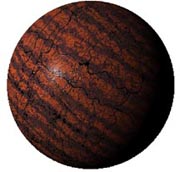 Red Pearls (Magical Element Water and Fire Rated MR 2)
Red Pearls (Magical Element Water and Fire Rated MR 2)
Red Pearls (Rust Pearls) are fresh water pearls that can be found in the river mussel grown in the river Tel-Slcies (Lady’s Dream) in Bryagel. They are also called Rust Pearls as they will sometimes look like a sphere of rusting iron. They are useful in all types of magick but especially in those of Wards, luck, love, water and fire. One quantity of Red Pearl acts as three quantities of materials in any fire or water magick device. Additionally if used in a magical device dedicated to water magick, the Red Pearls hold seven charges and restore 3 charges per day in the device. The quantity needed for a device or working of magick is 1 Ct. One has a 7% chance of finding Red Pearls in a store in Bryagel at a cost of 1800 P + and a 2% chance in shops in other countries with a minimum price of 1800 P+. The average size of a Red Pearl is .1 to .3 Ct.
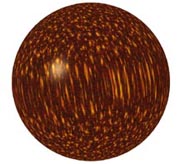 Great Red Pearls (Magical Element Water and Fire Rated MR 3)
Great Red Pearls (Magical Element Water and Fire Rated MR 3)
The Great Red Pearls are also called Flame Pearls as their coloration looks like a sphere of flame. These sea water pearls come from the great oysters of Moshven that are found off the coast of Moshven. They are prized not only for their luster and unusual colorization but for their arcane properties. Once enchanted, the Great Red Pearl can be used to store spells within it. A user of magick can store 10 MR of spells per Ct of Great Red Pearl. One can has a 5% chance of finding Great Red Pearls in a store in Moshven at a cost of 2100 P + and a 1% chance in shops in other countries with a minimum price of 2500 P+. The average size of a Great Red Pearl is .5 to 1.25 Ct. There have been occasions that enormous Great Red Pearls up to 8 Ct have been found in the Great Oysters of Moshven which themselves can grow to 25 lbs. in size.
Blue Pearls (Magical Element Water and Air rated MR 2)
The Blue Pearls are also known as Ice Pearls. Not just for their color, but for their unique ability to absorb heat. An Ice Pearl placed into a fluid will reduce its temperature. For every 1/10 of a ct placed in a gallon of water, the temperature will be reduced by 15 degrees C. If one places an Ice Pearl into one’s mouth, it will also drop the temperature by 14 degrees for every 1/10 Ct placed in the mouth. Healers dealing with fevers prize ice Pearls for their patients.
One quantity of enchanted Ice Pearls holds seven charges and restores three charges per day. When used in a magical device dedicated to water and air magicks, one quantity of Ice Pearl is equal to three quantities of magical materials. Ice Pearls are effective in Wards magick, Water magick, Air Magick, Searching for Luck, and for magicks dealing with aquatic animals.
If one were to take 10 quantities of enchanted Ice Pearls and grind them into a mixture with 1 gallon of water, it would yield enough to cover an average human set of armor. This coating, after drying and hardening, will provide 20 points of energy protection.
The Blue Pearls can be found in the waters off the northern coast of Kenda and the northern coast of Cellenda in the Azul Grand Oysters. One should note that Great Blue Sharks make their homes near and around the Azul Grand Oysters as it attracts the favorite prey of the Great Blue Sharks.
One can find Ice Pearls in a shop in Kenda and Cellenda about 25% of the time due to the difficulty of harvesting them. Their cost reflexes this difficulty of harvest as they cost 2100 P + per Ct. It is extremely rare to find Ice Pearls anywhere else in the Realms of Alquennas. If one is lucky enough to find an Ice Pearl in a shop on another continent they should be prepared to pay at least 3000 P + per Ct.
Chameleon Pearl (Magical Element All Rated MR 1)
The Chameleon Pearl is one of the rarest pearls in any of the Realms of Alquennas. The Chameleon Peal comes from the Tundra Oyster. This Oyster is only found in the waters of the tundra lands in the northern hemisphere of Alquennas. The Tundra Oysters are found in waters of depths of 200 feet or more. The pearls from the Tundra Oyster change color in different lights and in some lights become translucent. This is why they are named the Chameleon Pearls. They range in size from .75 Ct to 1.25 Ct. on average. There have been several examples of Tundra Oysters with Pearls that have measured over four to eight Ct.
Used in Transmutation magick, one quantity of enchanted Chameleon Pearl is equal to four quantities of magical materials. If one enchants four quantities of Chameleon Pearls and affixes the enchanted Chameleon Pearls to a garment, a cloak of blending will be created with the PSF% of 68% for Blending into Surroundings for any natural environment. This includes anywhere from the great forests to the Tundra to the great deserts of Alquennas. The cloak will also be effective in the small and great waters of the world of Alquennas.
One has a 3% chance of finding Chameleon Pearls in a shop in one of the countries of the northern hemisphere at a cost of 4000 P per Ct.
Return to Top
Armor Stone
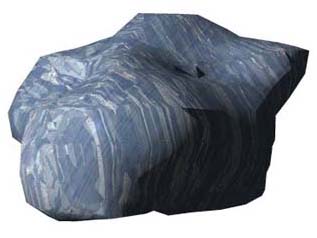 (Magical Element: Fire and Earth, MR 14)
(Magical Element: Fire and Earth, MR 14)
Armor Stone was discovered in BK 8500 by the Dwarves in Terla. It was not until TK 1035 that the Dwarves of the White Mountains (Azin) discovered how to work these dense stone. As the name suggests Armor Stone is a durable and tough material. The stone is harder than diamonds. Armor Stone can fetch up to 1 Crown per once for the raw stone. Armor Stone unlike other rocks are not subject to cracking using the Fire and Cold method, or the Fire and Vinegar methods of cracking. The Dwarves have created new methods and procedures to extract and shape Armor Stone. The outer ward wall of the Dwarven Fortress of North-Hold is comprised of Armor Stone. Armor Stone is also sought after for its beauty as well as its durability. Historical records indicated that several kings from different races have had fragments of Armor Stone added to their crowns. The scepter that the High King of Azin wields is comprised or Armor Stone.
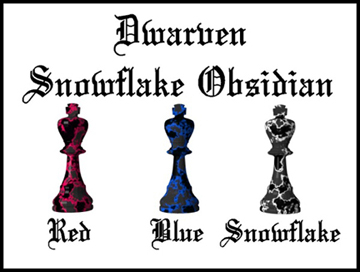
Red Flake Obsidian (Fire Obsidian)
Dwarven Red Flake Obsidian (Fire Obsidian) is a deep black with fiery red flecks within it. It is twice as hard as normal Obsidian and also takes and keeps an edge better than any iron-edged tool or weapon. Therefore, it is sharper. Dwarven healers use razors and other edged medical instruments crafted from Fire Obsidian. Many a fletcher and atilliator prize Fire Obsidian for arrowheads and missile bolt-heads as it is known for penetrating armor better than metal arrowheads. The only drawback is that these arrowheads and bolt-heads are prone to shatter while penetrating metal armor. This has its benefits because it damages the enemy more but means that these arrows are often unrecoverable.
If ½ pound of Fire Obsidian is affixed (non-magically) to any armor, it will reduce energy and fire damage by 3 points. It is said that Dwarven Vitki with their priestly magick can enchant Dwarven Fire Obsidian into armor that will reduce all energy and fire damage by 2/3. The Fire Obsidian is valued at 100 P per 1 Ct. and it is one of the items and materials that Dwarves will trade with other races.
Blue Flake Obsidian (Cold Stone)
Found beneath Lava tunnels (tubes), this deep black Obsidian is sprinkled with royal blue flecks. It is also known as Cold Stone for it has a unique property for the Obsidian family. Cold Stone reacts within seconds to any source of heat and is excellent at channeling it. If an amount is introduced internally into a living creature, their core temperature will begin to drop to below freezing as the Cold Stone absorbs the energy of the victim's body.
Dwarven engineers have used Blue Flake Obsidian to create boats that can sail across lava flows and form shields that can withstand the heat of Dragon Fire. It is said that one of the Gorgons of Patronna was slowed down by an arrow with a Cold Stone arrowhead. Demons of Fire are not fond of cold stone and will avoid it. This has led to the creation of Dwarven religious icons and medallions constructed of Cold Stone. The one draw back in using Cold Stone is that it is a very difficult material to work with. The standard technique of knapping the stone into the desired shape will not work with Cold Stone. The only material that can be used against it is Diamond or Dwarven Snow Flake Obsidian, the hardest of all of the Dwarven Obsidians. Dwarven Blue Flake Obsidian is valued at 120 P per 1 Ct. and it is one of the materials that Dwarves will trade with other races.
If ½ pound of Cold Stone is affixed (non-magically) to any armor, it will reduce energy and fire damage by 15 points. Cold Stone cannot be shaped into a complete suit of armor because to wear such a suit would kill the wearer within minutes. Using Cold Stone as an augmentation means that the wearer (or his squire!) must take care when handling the pieces of the armor.
(Fire's Blood) is found deep in the lava tunnels (magma tubes); this deep green Obsidian is sprinkled with black flecks. It is also known as Fire's Blood. The dwarves have found that they can melt this Fire's Blood and shape it into any shape. Then by adding specific ingredients, and allowing it to cure and cool, the dwarves have the ability to wield great power.
Green Flake Obsidian treated in this manner and shaped into an arrow head will result in the arrowhead exploding on impact doing 30 points of energy damage as well as 20 points of missile damage. The arrowheads are protected from exploding accidentally by a cover of silk and armor stone. This increases the cost of the arrowheads. The average cost of 20 arrowheads with protective covering is 4 Crs.
Green Flake Obsidian treated in this manner and shaped into a spear head will result in the spearhead exploding on impact doing 35 points of energy damage as well as 12 points of piecing damage. This increases the cost of the spearheads. The average cost of one spearhead with protective covering is 1 Cr.
Green Flake Obsidian treated in this manner and shaped into a lance head will result in the lance head exploding on impact doing 40 points of energy damage as well as 15 points of piecing damage. This increases the cost of the lance Head. The average cost of one lance Head with protective covering is 4 Crs.
The Green Flake Obsidian is not only useful in weapons. One once of raw Green Flake Obsidian ground into a mixture of pure water and garlic will reverse the effects of Sea Dragon poison and hydra poison. Additionally, adding an ounce of raw Green Flake Obsidian to a mixture of Algo root will double the effects of the Algo root in fighting Red Fever
An ounce of raw Green Flake Obsidian costs on an average of 25 P.
The rarest of all of the Dwarven Obsidians is the Dwarven Snowflake Obsidian. It can be identified and distinguished from other types of Snowflake Obsidian by the patterns of the white specks (the snowflakes). The Dwarven variety will have at least one perfectly shaped snowflake on both sides of the piece and sometimes more depending upon its size.
As the Dwarves mined the deeper reaches of the planet, they discovered numerous magma tubes. Most of the tube walls were comprised of thick strong stone that was slowly being melted by the magma as it traveled through them. However, some of the tubes were comprised of Obsidian with white flakes in it. Snowflake Obsidian had been known for centuries. This darker, richer, and purer form of Snowflake Obsidian was different. It did not melt at any temperature. The Dwarven Snowflake Obsidian has a uniform, strong, and extremely durable crystal structure that allows it to knap other stones including the other Dwarven stones and diamonds. Dwarven Snowflake Obsidian is valued at 240 P per 1 Ct. and on rare occasions, Dwarves will trade it with outside cultures.
Flame Rock (Dwarven Coal)
Flame Rock is an extremely rich and concentrated coal that burns twice as hot and twice as long as normal coal. Dwarven master foundrymen, black and white smiths, armorers and weaponsmiths prize Flame Rock as it allows them to gauge the temperatures of their furnaces and working fires accurately. Flame Rock is valued at 20 P per 100 pounds. Dwarves will trade this material to other cultures in limited quantities.
Return to Top
Dwarven Bronze
Bronze holds a special place within Dwarven society. This is because it was Bronze that taught the Dwarves the art of union of different materials to construct a better, stronger and more powerful one. In addition, the Dwarven ancestors learned the art of casting from Bronze. The Dwarves had hoped that when Men learned the art of Bronze, they would better understand their relationship with the planet. Unfortunately, Men either did not learn this lesson or did not bother to respect it.
Attempting to alloy Dwarven Copper and Dwarven Tin may or may not turn into Dwarven Bronze - even with a successfully metalworking skill. A successful roll with a Crit Die roll of 9 to 10 is needed. Dwarven Bronze combines the properties of Dwarven Copper and Dwarven Tin with the additional feature that it has an additional Magick Resistance of 3. Dwarven Bronze is prized highly and Dwarves will not trade it willingly to any other race, however, they will give items constructed of Dwarven Bronze to Dwarf Friends.
Dark Metal or Metal of Darkness
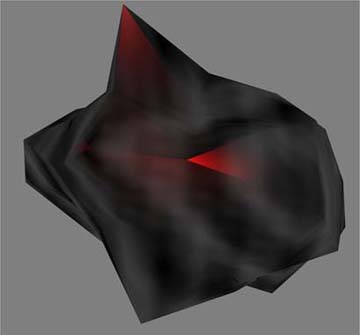 It is written that millennia ago Dwarven miners discovered a metal that reacted and interacted with other metals easily. It was thought that this new metal would be the answer to several troubling questions about the planet. They hoped it would allow them to heal the planet quicker than they had expected.
It is written that millennia ago Dwarven miners discovered a metal that reacted and interacted with other metals easily. It was thought that this new metal would be the answer to several troubling questions about the planet. They hoped it would allow them to heal the planet quicker than they had expected.
However, the Dwarves soon learned that Darkness had usurped the power of this metal to make their cursed swords, armor and other implements of destruction. The Dwarves are still studying Dark Metal to find the secrets to countering it. They will not offer Dark Metal for trade. They may trade with other races to remove quantities of Dark Metal FROM the world but any Dwarf found to be providing Dark Metal TO the world is subject to the highest penalties for treason from other Dwarves. They will gladly help any race to destroy it if any artifacts crafted from it are found after any battles with Demons, Unseelie or Undead.
It is known that Dark Metal can be added to other metals to increase their strength but that this strength comes with a high price. Items found that are formed of such alloys are known to drain the life away of their users. It is not known whether this is due to the Dark Metal itself, or to the loathsome enchantments that are usually imbued in these items.
Dwarven Pewter (MR 5 Element Earth)
Used in Wards, Illusions, Earth magicks. Dwarven magical Artisans will use Dwarven Pewter to carve or cast warding statues and protective amulets. Pewter is an alloy of tin with a variety of quantities of materials acting as a hardening agent. Dwarven Pewter uses Earth’s Blood when the Dwarven Pewter will be cast for protection amulets, and statues, and dwarven copper for other applications.
Dwarven Quicksilver (MR 1 Element All)
This rare form of mercury is solid at room temperature and melts at the boiling point of water into a liquid. The surface when solid ripples like water but is solid. Used in Earth, Air and Water magick it does double damage against fire loving creatures.
True Lead MR 21
Known as the Alchemical metal magick cannot target this material and for every pound of material magick cannot be targeted for a radius of five feet and magical effects are negated for 3 feet.
Return to Top
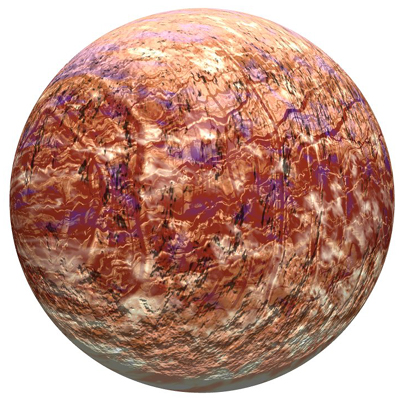
Sandstone of the Gallison Estralla Empire
The Sandstone of the Gallison Estralla Empire is the rarest stone known on Alquennas. The quarries of the Sandstone of the Gallison Estralla Empire have been lost since the fall of the Gallison Estralla Empire. The sandstone has a natural MR value of 0 and can only be cut using diamonds. It is amazing that most of the temples and tombs of the Gallison Estralla Empire are constructed with this material. For thousands of years knowledge seekers and treasure hunters have searched for the quarries that the Sandstone of the Gallison Estralla Empire can be found. This unique sandstone has a natural ward against the undead creatures. It is prized not only for its mystical abilities. The stone with its structure similar looking to sandstone is brilliantly colored in yellows to orange to browns has been a mystery for many millenniums. It is known that only the humans of the Gallison Estralla Empire worked with this material. The dwarves had no knowledge of this material until they came to Alquennas from the cross roads. The material is valued at 7,000 P per oz.
Return to Top
 (Magical Element: Fire and Earth, MR 14)
(Magical Element: Fire and Earth, MR 14) Green Pearls (Magical Element Earth, Fire and Water rated at MR 2)
Green Pearls (Magical Element Earth, Fire and Water rated at MR 2) Red Pearls (Magical Element Water and Fire Rated MR 2)
Red Pearls (Magical Element Water and Fire Rated MR 2) Great Red Pearls (Magical Element Water and Fire Rated MR 3)
Great Red Pearls (Magical Element Water and Fire Rated MR 3)
 It is written that millennia ago Dwarven miners discovered a metal that reacted and interacted with other metals easily. It was thought that this new metal would be the answer to several troubling questions about the planet. They hoped it would allow them to heal the planet quicker than they had expected.
It is written that millennia ago Dwarven miners discovered a metal that reacted and interacted with other metals easily. It was thought that this new metal would be the answer to several troubling questions about the planet. They hoped it would allow them to heal the planet quicker than they had expected.
